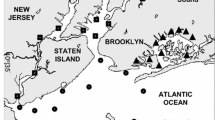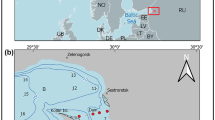Abstract
In Narragansett Bay, light attenuation by total suspended sediments (TSS), colored dissolved organic matter (CDOM), and phytoplankton chlorophyll-a (chl-a) pigment is 129, 97, and 70%, respectively, of that by pure seawater. Spatial distribution of light attenuation indicates higher values in the upper Bay, where rivers with sediment and nutrient-rich waters enter and elevate TSS, CDOM, and chl-a concentrations. The temporal trends of light attenuation during the summer months (July–August) differed at various locations in the Bay, having the highest values in July. For the same period, spectral methods overestimated attenuation throughout the Bay. These findings quantify the behavior of light attenuation in space and time, providing information that can guide decisions related to improving water clarity and help understanding the effects of various environmental and management scenarios on it.













Similar content being viewed by others
References
Abdelrhman, M.A. 2015. Three-dimensional modeling of the hydrodynamics and transport in Narragansett Bay. United States Environmental Protection Agency Report EPA/600/R-15/152, pp. 171.
Abdelrhman, M.A. 2016a. Three-dimensional modeling of water quality and ecology in Narragansett Bay. United States Environmental Protection Agency Report EPA/600/R-16/203, pp. 130.
Abdelrhman, M.A. 2016b. Modeling total suspended solids (TSS) concentrations in Narragansett Bay, United States Environmental Protection Agency Report EPA/600/X-16/087, pp. 77.
Abdelrhman, M.A., and K.W. Bedford. 1990. Similarity analysis of the temporal variation of suspended sediment profiles. Journal of Geophysical Research 95(C9): 16217–16227.
Alver, M.O., K. Hancke, E. Sakshaug, and D. Slagstad. 2014. A spectrally-resolved light propagation model for aquatic systems: steps toward parameterizing primary production. Journal of Marine Systems 130: 134–146.
Babin, M., D. Stramske, G.M. Ferrari, H. Claustre, A. Bricaud, G. Obolensky, and N. Hoepffner. 2003. Variations in the light absorption coefficients of phytoplankton, nonalgal particles, and dissolved organic matter in coastal waters around Europe. Journal of Geophysical Research 108(C7): 3211. doi:10.1029/2001JC000882.
Barausse, A. 2008. Light extinction. Reference module in earth systems and environmental sciences, Encyclopedia of Ecology, 2008, Pages 2180–2184, current as of 20, June 2014, Academic Press.
Bricaud, A., and D. Stramski. 1990. Spectral absorption coefficients of living phytoplankton and nonalgal biogenous matter: a comparison between the Peru upwelling area and the Sargasso Sea. Limnology and Oceanography 35(3): 562–582.
Bricaud, A., M. Babin, A. Morel, and H. Claustre. 1995. Variability in chlorophyll-specific absorption coefficients of natural phytoplankton: analysis and parameterization. Journal of Geophysical Research 100: 13321–13332.
Buiteveld, H., J.H.M. Hakvoort, and M. Donze. 1994. The optical properties of pure water. Ocean Optics XII, SPIE 2258: 174–183.
Civera, J.I., I.R. Gil, N. Laguarda-Miro, E. Garcia-Breijo, L. Gil-Sanchez, and R. Martinez-Guijarro. 2011. Instrument for sunlight extinction measurement in water bodies. Sensors and Actuators A: Physical 168(2): 267–274.
Conmy, R.N., B.A. Schaffer, J. Schubauer-Berigan, J. Aukamp, A. Duffy, J.C. Lehrter, and R.M. Greene. 2016. Characterizing light attenuation within Northwest Florida Estuaries: implications for RESTORE Act water quality monitoring. Marine Pollution Bulletin. doi:10.1016/j.marpolbul.2016.11.030.
Dennison, W.C. 1987. Effects of light on seagrass photosynthesis, growth and depth distribution. Aquatic Botany 27: 15–26.
Fujii, M., E. Boss, and F. Chai. 2007. The value of adding optics to ecosystem models: a case study. Biogeosciences 4: 817–835.
Gallegos, C.L. 1994. Refining habitat requirements of submersed aquatic vegetation: role of optical models. Estuaries 17(1B): 187–199.
Gallegos, C.L. 2001. Calculating optical water quality targets to restore and protect submerged aquatic vegetation: overcoming problems in partitioning the diffuse attenuation coefficient for photosynthetically active radiation. Estuaries 24(3): 381–397.
Gallegos, C.L., and W.J. Kenworthy. 1996. Seagrass depth limits in the Indian River Lagoon (Florida, USA): application of an optical water quality model. Estuarine Coastal and Shelf Science 42: 267–288.
Gallegos, C.L., and K.A. Moore. 2000. Factors contributing to water-column light attenuation. Chapter IV in Chesapeake Bay submerged aquatic vegetation water quality and habitat-based requirements and restoration targets: a second technical synthesis. Pp. 35–54.
Gallegos, C.L., and P.J. Neal. 2002. Partitioning spectral absorption in case 2 waters: discrimination of dissolved and particulate components. Applied Optics 41(21): 4220–4233.
Geider, R.J. 1987. Light and temperature dependence of the carbon to chlorophyll a ratio in microalgae and cyanobacteria: implications for physiology and growth of phytoplankton. The New Phytologist 106: 1–34.
Gibson, J.H. 2000. UVB radiation: definition and characteristics. USDA UVB Monitoring and Research Program, Natural Resource Ecology Laboratory, Colorado State University. Retrieved (12/2/2016) from http://uvb.nrel.colostate.edu/UVB/publications/uvb_primer.pdf.
Gregg, W.W. and K.L. Carder. 1990. A simple solar irradiance model for cloudless maritime atmospheres. Limnology and Oceanography 35(8): 1657–1675.
IOCCG. 2003. Models, parameters and approaches that are used to generate wide range of absorption and backscattering spectra. International Ocean Color Coordinating Group, Ocean color algorithm working group. 9 pp. http://www.ioccg.org/groups/lee_data.pdf. Accessed 30 July 2015.
Keith, D.J., J.A. Yoder, and S.A. Freeman. 2002. Spatial and temporal distribution of colored dissolved organic matter (CDOM) in Narragansett Bay, Rhode Island: implications for phytoplankton in coastal waters. Estuarine Coastal and Shelf Science 55: 705–717.
Kenworthy, W.J., C.L. Gallegos, C. Costello, D. Field, and G. diCarlo. 2014. Dependence of eelgrass (Zostera marina) light requirements on sediment organic matter in Massachusetts coastal bays: implications for remediation and restoration. Marine Pollution Bulletin 83: 446–457.
Kirk, J.T.O. 1994. Light and photosynthesis in aquatic ecosystems. second ed. New York: Cambridge University Press.
Kowalczuk, P., C.A. Stedmon, and S. Markager. 2006. Modeling absorption by CDOM in the Baltic Sea from season, salinity and chlorophyll. Marine Chemistry 101: 1–11.
Lee, R.W., and W. Rast. 1997. Light attenuation in a shallow, turbid reservoir, Lake Houston, Texas. U.S. Geological Survey, Water-Resources Investigations Report 97-4064.
Matsuoka, A., V. Hill, Y. Hout, M. Babin, and A. Bricaud. 2011. Seasonal variability in the light absorption properties of western Arctic waters: parameterization of individual components of absorption for ocean color applications. Journal of Geophysical Research 116(C02007): 1–15.
Mobley, C.D., B. Gentili, H.R. Gordon, Z. **, G.W. Kattawar, A. Morel, P. Reinersman, K. Stamnes, and R.H. Stavn. 1993. Comparison of numerical models for computing underwater light fields. Applied Optics 32(36): 74847504.
Mobley, C.D., F. Chai, P. **u, and L.K. Sundman. 2015. Impact of improved light calculations on predicted phytoplankton growth and heating in idealized upwelling-downwelling channel geometry. Journal of Geophysical Research: Oceans. doi:10.1002/2014JC010588.
Murray, C., S. Markager, C.A. Stedmon, T. Juul-Pedersen, M.K. Sejr, and A. Bruhn. 2015. The influence of glacial melt water on bio-optical properties in two contrasting Greenlandic fiords. Estuarine, Coastal and Shelf Science 163: 72–83.
Prieur, L., and S. Sathyendranath. 1981. An optical classification of coastal and oceanic waters based on the specific spectral absorption curves of phytoplankton pigment, dissolved organic matter, and other particulate materials. Limnology and Oceanography 26(4): 671–689.
Sathyendranath, S. 1984. Inherent optical properties of natural seawater. Defense Science Journal 34: 1–18.
Thursby, G., S. Rego, and D. Keith. 2015. Data report for calibration of bio-optical model for Narragansett Bay. United States Environmental Protection Agency Report tracking number EPA/600/R-15/211, pp. 24.
Watanabe, S., I. Laurion, S. Markager, and W.F. Vincent. 2015. Abiotic control of underwater light in a drinking water reservoir: photon budget analysis and implications for water quality monitoring. Water Resources Research 51: 6290–6310.
Weast, R.C., eds. 1980. Handbook of chemistry and physics. Cleveland, Ohio: Chemical Rubber Co..
Wilcox, S. 2012. National solar radiation database 1991–2010 update: user’s manual. NREL/TP-5500-54824. Oak Ridge, TN: US Department of Energy 59.
**u, P., and F. Chai. 2014. Connections between physical, optical and biogeochemical processes in the Pacific Ocean. Progress in Oceanography 122: 30–53.
Zhang, Y., B. Qin, G. Zhu, L. Zhang, and L. Yang. 2007. Chromophoric dissolved organic matter (CDOM) absorption characteristics in relation to fluorescence in Lake Taihu, China, a large shallow subtropical lake. Hydrobiologia 581: 43–52.
Acknowledgments
The author’s gratitude is due to Candace Oviatt and Heather Stoffel, University of Rhode Island, Graduate School of Oceanography, Narragansett, RI, for providing irradiance and chlorophyll measurements. The author commends Ms. Roxanne Johnson for providing TSS data for Narragansett Bay. The author also thanks the in-house reviewers of this manuscript including Drs. Dan Campbell, Henry Walker, and Naomi Detenbeck (USEPA-AED) as well as the journal anonymous reviewers for their technical reviews, insights, and constructive comments. Although the research described here has been funded by the US Environmental Protection Agency, it has not been subject to Agency-level review and therefore does not necessarily reflect the views of the Agency, nor does mentioning trade names or commercial products endorse or recommend them. This manuscript is contribution no. ORD-015494 of USEPA Office Research and Development, National Health and Environmental Effects Research Laboratory, Atlantic Ecology Division.
Author information
Authors and Affiliations
Corresponding author
Additional information
Communicated by Marianne Holmer
Dr. Abdelrhman passed away before the publication of this article. Address correspondence to: Glen Thursby,e-mail: thursby.glen@epa.gov
Appendix A. Spectrum Distribution Function (Table 2)
Appendix A. Spectrum Distribution Function (Table 2)
The spectrum distribution function is calculated from the extraterrestrial solar irradiance at the top of the atmosphere. Gregg and Carder (1990) present mean extraterrestrial irradiance values at all wave lengths λ within the range 350 to 700 nm. Values of the spectrum distribution function are identified from this information. First, irradiance values at 5-nm increments are extracted, f(λ j ) (W m−2 nm−1), λ j is the wave length (nm), and j is a counter for values within the PAR (400–700 nm) (j = 1 to 61). Second, the normalized values, which represent the distribution function f(λ j ), are obtained by dividing each f(λ j ) by the total sum of all the extracted values, i.e.,
where f(λj) (dimensionless) is the distribution function which has a unit area, i.e.,
It is assumed that the spectrum distribution function, f(λ j ), maintains its shape and unit area throughout the atmosphere down to the water surface (Table 2). The 5-nm increment cancels out from the numerator and denominator in Eq. (20).
Rights and permissions
About this article
Cite this article
Abdelrhman, M.A. Quantifying Contributions to Light Attenuation in Estuaries and Coastal Embayments: Application to Narragansett Bay, Rhode Island. Estuaries and Coasts 40, 994–1012 (2017). https://doi.org/10.1007/s12237-016-0206-x
Received:
Revised:
Accepted:
Published:
Issue Date:
DOI: https://doi.org/10.1007/s12237-016-0206-x




